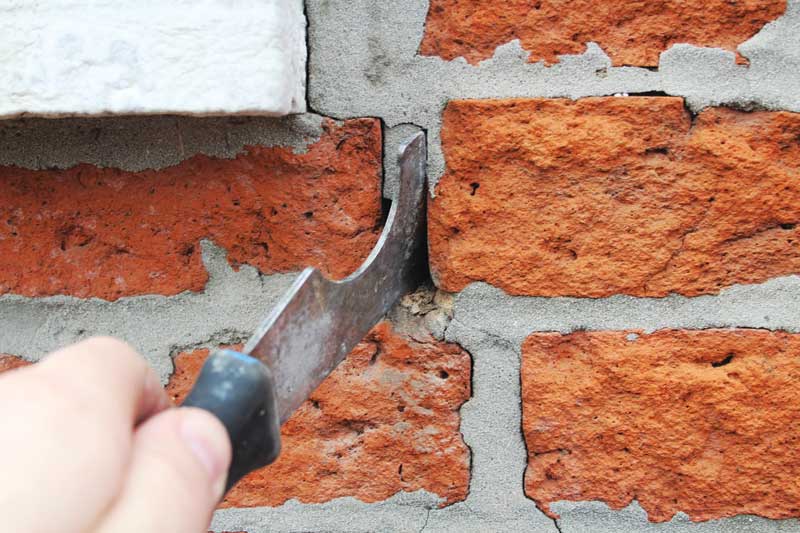

 FAILURES
FAILURES
Deborah Slaton, David S. Patterson, AIA, and Kenneth M. Itle
Using a mortar harder than adjacent stone or brick can affect the adjacent masonry, from localized spalls along the edges of the mortar joints to severely deteriorated masonry units surrounded by intact pointing mortar.
The mortar is intended to be sacrificial, but where it is harder than the masonry, stresses caused within the wall (e.g. by movement, loadings, and expansion related to moisture or thermal changes) are relieved by spalling the masonry units rather than the mortar. In this situation, the mortar may remain intact while the masonry deteriorates. Excessively hard and impervious pointing mortar can also trap moisture in the wall, accelerating deterioration of the original setting mortar.
ASTM C270, Standard Specification for Mortar for Unit Masonry, defines four types of mortar composed of Portland cement, lime, and sand. (Other useful references on this topic include Brick Industry Association [BIA] Technical Notes 8 and 8B on mortars and National Park Service [NPS] Preservation Brief No. 2, Repointing Mortar Joints in Historic Masonry Buildings.) Each type—M, S, N, and O—is specified by proportions and properties. (Since 1982, a fifth—Type K—has been included only in an appendix.)

Photo courtesy WSE
Type N mortar, which is commonly used with contemporary and especially older masonry, is specified with a minimum compressive strength of 5.2 MPa (750 psi), and proportions of 1.0 part Portland cement to 0.5 to 1.25 parts hydrated lime, and sand equal to 2.25 to 3.0 times the sum of the cementitious materials (1:1:6 is a commonly specified proportion). Type S mortar, used more often with below-grade walls, has a minimum compressive strength of 12.4 MPa (1800 psi), and proportions of 1.0 part Portland cement to 0.25 to 0.5 parts hydrated lime, and sand equal to 2.25 to 3.0 times the sum of the cementitious materials (1:½:4½ is a commonly specified proportion). Thus, Type N mortar has a lower compressive strength, and also a lower proportion of Portland cement to lime, than Type S.
However, it is worth noting the compressive strengths specified in ASTM C270 are minimums. When samples of typical new mortar mixes are tested, much higher compressive strengths are common. While not included in ASTM C270, mortars containing lime and sand without Portland cement are sometimes employed with older or softer masonry. These ‘lime’ mortars typically have relatively low compressive strengths as compared to Portland cement mortars.
Typical compressive strengths of brick and stone masonry units can vary depending on material and condition, ranging from less than 4.1 MPa (600 psi) for a soft brick to more than 131 MPa (19,000 psi) for granite. Selection of a mortar mix for pointing should account for environmental conditions and exposure, aesthetic factors (e.g. mortar color, texture, and tooling), and masonry unit strength, permeability, and condition. A basic guideline for selecting mortar is to use a mortar no stronger than is necessary in order to satisfy the wall’s structural requirements, ensuring it is less strong (i.e. softer) than the adjacent masonry substrate and the original setting mortar.
If existing masonry exhibits conditions indicating the mortar is too hard, testing for composition and compressive strength should be performed to confirm whether this is the cause of distress. If so, consideration should be given to removing and replacing the mortar. Deterioration that occurs over time within mortar joints can be repaired through repointing, but cracking or severe spalling within the masonry units usually requires replacement.
The opinions expressed in Failures are based on the authors’ experiences and do not necessarily reflect those of The Construction Specifier or CSI.
Deborah Slaton is an architectural conservator and principal with Wiss, Janney, Elstner Associates (WJE) in Northbrook, Illinois, specializing in historic preservation and materials conservation. She can be reached at dslaton@wje.com.
David S. Patterson, AIA, is an architect and senior principal with the Princeton, New Jersey, office of WJE, specializing in investigation and repair of the building envelope. He can be e-mailed at dpatterson@wje.com.
Kenneth M. Itle, AIA, is an architect and associate principal in WJE’s Northbrook, Illinois, office, specializing in historic preservation. He can be reached at kitle@wje.com.




